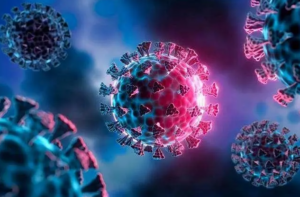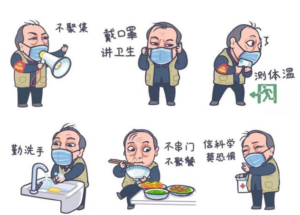
Prevent serious illness, remember the 4 “early”
The peak of fever clinics and emergency clinics has gradually passed
Up to now, the number of fever clinics in medical institutions above the second level nationwide is 16,400, and the number of fever clinics or fever clinics in primary health care institutions is 43,100 [1].
The release said that from last December to the present, the highest single-day number of fever outpatient visits nationwide was nearly 3 million, which occurred on December 23, 2022, and the highest single-day number of emergency department visits nationwide was over 1.5 million, which occurred on January 2, 2023 [1].
Recently, however, hospital outpatient volumes are gradually returning to normal treatment patterns.
On January 12, 2023, the total number of general outpatient visits nationwide was 9.135 million, which basically returned to the pre-epidemic level. The percentage of patients with positive new crown infections among outpatient visits on that day was 0.9% [1].
These trends were observed in both urban and rural areas, and based on data trend analysis, the peak of this wave of neo-crown infections has gradually passed [1].
The number of severe cases of neo-crown remains at a high level
The highest number of single-day readmissions for neo-coronary infections was reported to exceed 120,000 patients, occurring on January 5, 2023. Currently, although the number of severe cases is gradually decreasing, it is still at a high level [1].
Analysis of the data shows the following characteristics of critically ill patients with neo-coronavirus infection [1].
predominantly elderly
The average age is 75.5 years; the oldest person is 105 years old; the percentage of those aged 60 years and above is 89.6%.
Prevalent combination of multiple underlying diseases
Patients with one underlying disease accounted for 40.7%, 2 underlying diseases accounted for 24.6%, and 3 or more underlying diseases accounted for 34.8%. Underlying diseases, mainly include cardiovascular and cerebrovascular diseases (such as coronary heart disease, cerebral infarction, etc.), endocrine system diseases (diabetes, etc.) and respiratory system diseases (chronic obstructive pulmonary disease, bronchitis, etc.).
Nearly 60,000 deaths since December, mostly elderly people with underlying diseases
From December 8 to January 12, 2023, there were 59,938 hospital deaths related to the new crown nationwide, with an average age of 80.3 years for the deaths, and about 90.1% of the cases were 65 years and older, including about 56.5% of those aged 80 years and older [1].
Overall, the older the age, the more severe the disease and the higher the risk of death.
More than 90% of the deaths were combined with underlying conditions, including cardiovascular disease, advanced tumors, cerebrovascular disease, respiratory disease, metabolic disease, and renal insufficiency.
Since winter itself is a season of high incidence of respiratory diseases and exacerbation of cardiovascular diseases in the elderly, combined with the recent overlap with neocoronavirus infections, the number of elderly people who die from illness is also higher [1].
Our mortality criteria are generally consistent with those of the World Health Organization and other major countries in determining deaths. The attribution analysis of deaths associated with neo-coronavirus infection is divided into two categories.
Deaths from neocoronavirus infection resulting in respiratory failure.
Deaths from underlying disease combined with neo-coronavirus infection.
What are effective ways to prevent severe illness in the elderly?
Elderly people, especially those with underlying diseases, are the ones who need priority protection.
The best way to prevent serious illness and death is – to reduce the risk of infection.
In addition, the highest priority protection is vaccination. Seniors who have not completed their vaccinations must get them done as soon as possible, including booster shots.
Even in the case of infected seniors, available research confirms that the immunity produced by neocoronavirus infection alone is weaker than the immunity produced by a combination of natural infection and vaccination. Under current regulations, older adults who have been infected with and recovered from a neo-coronavirus infection and who have not received (or have not received the full course of) neo-coronavirus vaccination may receive the vaccine after a 6-month interval between infections.
For elderly people who have been infected with neo-coronavirus, in the community, early detection, early identification, early treatment, and early referral are achieved, and a subdivision responsibility system is set up in tertiary hospitals to open up green channels for serious referrals and combine Chinese and Western medicine to treat patients to further reduce the rate of serious illness and death.
How to detect and identify seriously ill patients in the community at an early stage?
The following initiatives have been taken in the following areas: early detection, early identification, early treatment and early referral in the community.
Organize the second and third level hospitals to send down, mutual support and other ways to stabilize and expand the staff of primary health care institutions. At the same time, the “Guide to Primary Care and Services for Novel Coronavirus Infection (First Edition)” was developed to strengthen the training of primary medical personnel, focusing on improving the ability for early identification and early referral.
Strengthening drug readiness by establishing a monitoring and dispatching mechanism to dynamically grasp the drug stockpile and use in township health centers, providing timely notification and reminders, and urging enhanced drug provision.
Strengthen the provision and use of oxygen bags, oxygen cylinders, oxygen machines and finger pulse oxygen, which are instruments and equipment in primary medical and health institutions.
The establishment of special classes for the transfer of seriously ill patients within the county, to ensure that the emergency telephone number for medical consultation is dialed 24 hours a day, with a car dispatched, out of the car quickly, each township health center should be equipped with at least one ambulance, to accept the 120 unified command and dispatch, to promote the implementation of local responsibility of the township, the formation of non-emergency transfer fleet, to protect the needs of ordinary patient transfer.
The last wave of new coronavirus infection peak has gradually passed, we have to balance the mind, do a good job of protection, overcome fear, but also will eventually win in the fight with the new crown!


Average Rating